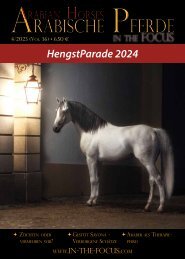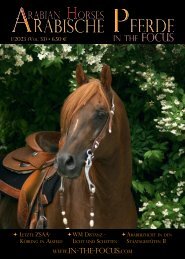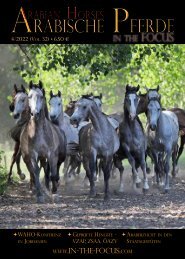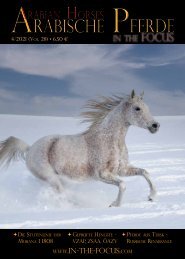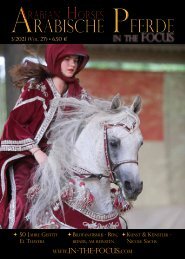Arabische Pferde IN THE FOCUS Nr. 3-2020 (Vol. 23) - public
Zeitschrift für Liebhaber und Züchter arabischer Pferde
Zeitschrift für Liebhaber und Züchter arabischer Pferde
Sie wollen auch ein ePaper? Erhöhen Sie die Reichweite Ihrer Titel.
YUMPU macht aus Druck-PDFs automatisch weboptimierte ePaper, die Google liebt.
Zucht<br />
Tabelle 2 - Anzahl der Stämme im Ländervergleich<br />
Stämme Syrien Iran Bahrain Saudi Ägypten<br />
Saglawiet Ibn Bisra<br />
x<br />
Saglawieh Jedranieh x x x x<br />
Saglawieh Jedranieh Ibn Zobeini x<br />
Saglawieh Jedranie Ibn Amoud x<br />
Saglawieh Shaifieh<br />
x<br />
x<br />
Saglawieh Marzakanieh<br />
x<br />
Saglawieh Sofreirieh<br />
x<br />
Saglawieh Al Abd<br />
x<br />
Koheilan Afas<br />
x<br />
Koheilan Ajuz x x x x<br />
Koheilan Ajuz Ibn Jleidan<br />
x<br />
Koheilan Al Adiyat<br />
x<br />
Koheilan Al Kubeysha<br />
x<br />
Koheilan Al Musineh<br />
x<br />
Koheilan Al Rabdah x x<br />
Koheilan Al Sekti<br />
x<br />
Koheilan Al Tewaiseh<br />
x<br />
Koheilan Al Wati<br />
x<br />
Koheilan Armousheh<br />
x<br />
Koheilan Da‘ajanieh<br />
x<br />
Koheilan Da‘ajanieh Kasher<br />
x<br />
Koheilan Hablanieh<br />
x<br />
Koheilan Haifieh<br />
x<br />
Koheilan Halabieh<br />
x<br />
Koheilan Hetli<br />
x<br />
Koheilan Ibn Mizher<br />
x<br />
Koheilan Jalfat Sattam Al Boulad x<br />
Koheilan Jalfet Dahwi<br />
x<br />
Koheilan Jellabieh x x<br />
Koheilan Jreibeh<br />
x<br />
Koheilan Khalawieh<br />
x<br />
Koheilan Khidlieh<br />
x<br />
Koheilan Krush x x x x<br />
Koheilan Krush Al Abaida<br />
x<br />
Koheilan Memrahieh<br />
x<br />
Koheilan Nawakieh<br />
x<br />
Koheilan Nesman<br />
x<br />
Koheilan Reeshah Sarabieh<br />
x<br />
Koheilan Rodan<br />
x<br />
Koheilan Sa‘adat Touqan<br />
x<br />
Koheilan Um Arqoub x x<br />
Koheilan Um Janoub<br />
x<br />
Koheilan Um Zorayr<br />
x<br />
Hamdaniat Ibn Ghorab<br />
x<br />
Hamdanieh Semrieh x x x<br />
x x<br />
Hamdanieh Al Efri<br />
x<br />
Obayet Ibn Sehayan<br />
x<br />
Obayet Um Jreis x x<br />
x<br />
Obeyah Seheilieh<br />
x<br />
Obeyah Sharakieh x x<br />
Obeyan Al Seifi<br />
x<br />
Ma‘anagieh Sbeylieh x x<br />
x<br />
Ma‘anagieh Sbeiliet Abou Saifain x<br />
x<br />
Ma‘anagieh Hadraouji x x<br />
Shweimat Sabbah x x x x<br />
Hadban Enzahi x x<br />
Hadban Enzahi Al Fawaarah<br />
x<br />
Dahmah Amir<br />
x<br />
Dahman Shahwan<br />
x<br />
Wadne Khersan<br />
x<br />
Wadne Koheileh<br />
x<br />
Hargeh<br />
x<br />
Jelfan / Julfah x x<br />
Kray<br />
x<br />
Meleihe<br />
x<br />
Mlolshaan<br />
x<br />
Naimeh<br />
x<br />
Saadeh<br />
x<br />
Saida<br />
x<br />
Shawaf<br />
x<br />
Suwaiti El Farim<br />
x<br />
Tuwaisaan<br />
x<br />
Gesamtzahl 45 17 16 11 12<br />
Asil-Araber im Iran / copyright by Gudrun Waiditschka Asil-Club, 5. Sept. <strong>2020</strong><br />
6<br />
Lewis Pelly's Hinweis auf die Wadne Khersan<br />
im Nedjd. - Lewis Pelly's mentioning of the<br />
Wadne Khersan in the Nedjd.<br />
was increased and the genetic diversity continued<br />
to decrease through breeding selection for<br />
individual famous animals.<br />
As the table also shows, the Wadne Khersan<br />
only exists in Iran. The Djelfe (Jelfan, Julfan)<br />
also only seem to exist here and Bahrain, albeit<br />
in small numbers. Muniqis used to exist in Egypt<br />
too, but these have now died out there.<br />
Characteristics of the Asil Iranians<br />
Populations with high genetic diversity are<br />
optimally adapted to their environment and<br />
their use. This also applies to the Iranian Arabian<br />
horses.<br />
In order to find pastureland for their flocks of<br />
sheep, the nomadic tribes undertook a vertical<br />
migration from winter camps in the plains<br />
of Khuzestan to summer camps in the Zagros<br />
Mountains until the 1970s. In this way they tried<br />
to escape the hot summer temperatures in Khuzestan<br />
and to use new grazing grounds. During<br />
this migration, mountain passes of 3000 m<br />
had to be managed, the distance was 300 km<br />
(one way) and was covered in about 5-6 days.<br />
Stallions and sometimes the mares were ridden,<br />
the young horses ran free. In contrast, the Bedouins<br />
of Arabia undertook a horizontal migration,<br />
following the rain and fresh pastureland.<br />
The following characteristics resulted from<br />
these demands on the horses:<br />
• perseverance<br />
• surefootedness<br />
• rideability<br />
• character<br />
These inner properties are more important to<br />
the Iranians than any external appearance.<br />
But how can one maintain these inner properties<br />
in a population? This is primarily done<br />
through appropriate use, in which the horses<br />
have to prove themselves - or not, and<br />
as a consequence they are then withdrawn<br />
from breeding. Katharina Ghalavand and<br />
her daughter Katayoun organize trail rides in<br />
Khuzestan and in the Zagros Mountains (not<br />
only, but also) for this purpose. These rides<br />
follow in the footsteps of the nomads' migrations.<br />
They want to keep the memory of the old<br />
breeding tradition alive, but also subject their<br />
breeding animals to a "performance test" in<br />
doing so.<br />
Another type of "performance test" are races<br />
and endurance rides. Unfortunately, there are<br />
French racing Arabians running in the races<br />
12<br />
© ARABISCHE PFERDE - <strong>IN</strong> <strong>THE</strong> <strong>FOCUS</strong> 3/<strong>2020</strong>




